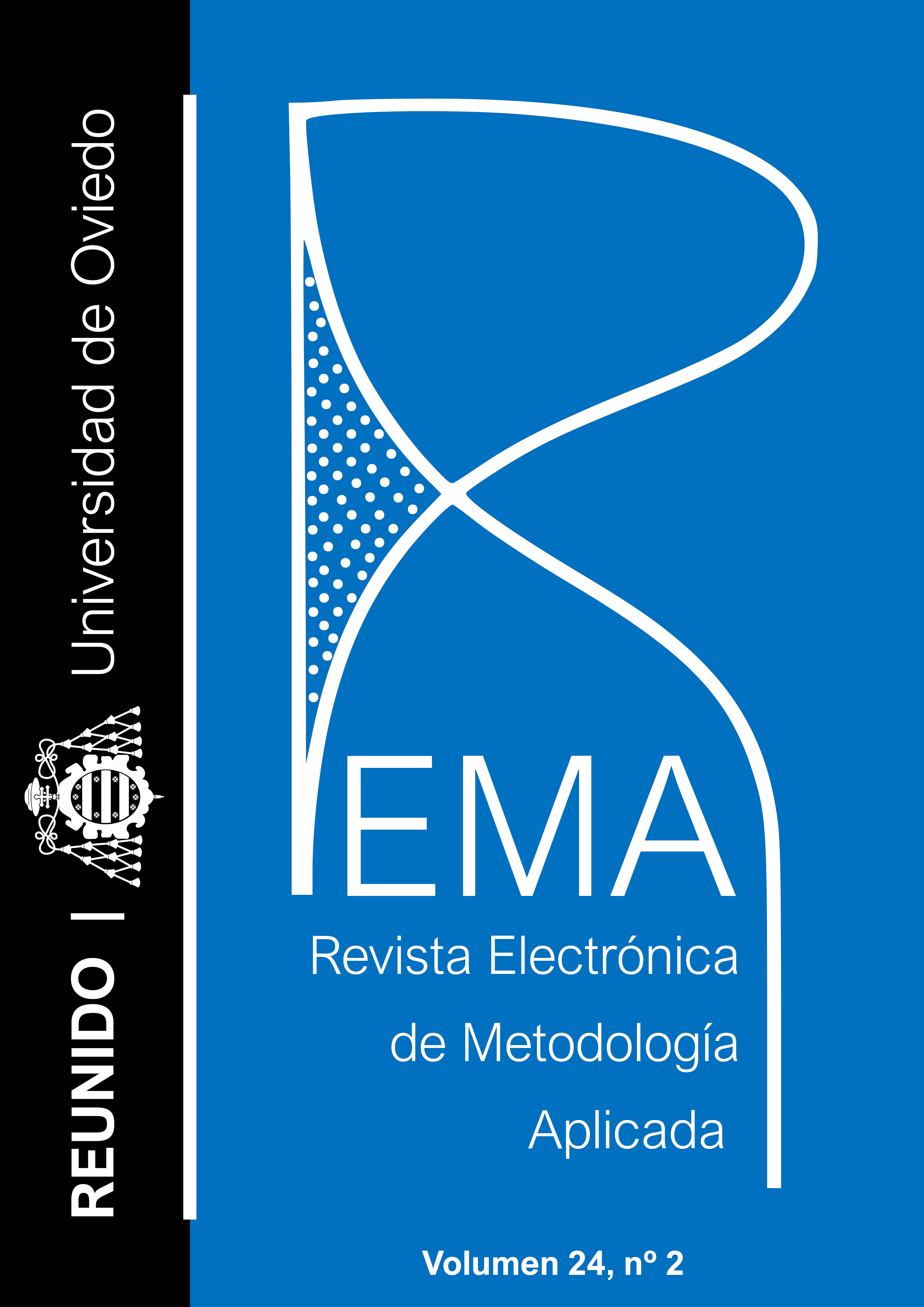Abstract
Sonification is a representation and analysis tool that uses sound as conductor of a series of data. The transcription to frequency, intensity and timbre allows expressing different magnitudes and nuances of a set of observations. In this text, the fundamentals of the sonification will be shown, as well as its most common uses in psychology: motor learning, perceptual discrimination and representation of responses in certain pathologies that connect with the role of rhythm as essential factor in the organization of the organic. Through the compilation of the existing bibliography, sonification applications and their possibilities in other fields of psychology will be exposed. As an example, a simple conversion of the graphic representation of a normal curve into its auditory version is proposed. As a final interpretation, the possibilities of sound as a methodological tool for data analysis will be highlighted, opening interdisciplinary and multisensory paths in research.
References
Bergstrom, I., Seinfeld, S., Arroyo-Palacios, J., Slater, M. & Sanchez-Vives, M. V. (2014). Using Music as a Signal for Biofeedback. International Journal of Psychophysiology, 93(1), 140-149. https://doi.org/10.1016/j.ijpsycho.2013.04.013
Bigerelle M. & Iost A. (2000). Fractal dimension and classification of music. Chaos Solitons Fractals, 11 (14), 2179-2192.
Broadbent, D. E. (1958). Perception and communication. Oxford University Press.
Buehler, M. (2020). Nanomechanical sonification of the 2019-nCoV coronavirus spike protein through a materiomusical approach. ArXhiv.org. https://doi.org/10.48550/arXiv.2003.14258
Burdick, K.J., Jorgensen, S.K., Combs, T.N., Holmberg, M.O., Kultgen, S.P. & Schlesinger, J.J. (2020)
SAVIOR ICU: sonification and vibrotactile interface for the operating room and intensive care unit. Journal of Clinical Monitoring and Computing, 34 (4), 787-796. https://doi/10.1007/s10877-019-00381-1
Cairo, A. (08 de mayo de 2022). Sonifying data with TwoTone. http://www.thefunctionalart.com/2019/03/sonifying-data-with-twotone.html
Cusack, R. & Roberts, B. (2000). Effects of differences in timbre on sequential grouping. Perception & Psychophysics, 62(5), 1112–1120. https://doi.org/10.3758/BF03212092
Delogu, F., Belardinelli, M.O., Palmiero, M., Pasqualotto, E., Zhao, H., Plaisant, C. & Federici, S. (2006). Interactive sonification for blind people exploration of geo-referenced data: comparison between a keyboard exploration and a haptic-exploration interfaces. Cognitive Processing, 7, 178–179. https://doi.org/10.1007/s10339-006-0137-8
Diaz-Merced, W. L., Candey, R. M., Brickhouse, N., Schneps, M., Mannone, J. C., Brewster, S. & Kolenberg, K. (2012). Sonification of Astronomical Data. New Horizons in Time Domain Astronomy, 285, 133-136. https://doi.org/10.1017/S1743921312000440
Ecalle, J., Boisson, A., Labat, H., Versace, R. & Magnan A. (2021) Spatial sonification of letters on tablets to stimulate literacy skills and handwriting in 5 y-o children: A pilot study. Human Movement Science, 79,102844. https://doi.org/10.1016/j.humov.2021.102844
Edwards, A. D. N., Hunt, A., Hines, G., Jackson, V., Podvoskis, A., Roseblade, R. & Stammers, J. (2010). Sonification strategies for examination of biological cells. en E. Brazil (Ed.), 16th International Conference on Auditory Display (193–200). Georgia Tech Library.
Harkleroad, L. (2006). The math behind the music. Cambridge University Press.
Lautenschlaeger, G. (2018). Absences within and surrounding light-to-sound translations. Journal of Science and Technology of the Arts, 10(3), 3-13. https://doi.org/10.7559/citarj.v10i3.565
Kramer, G., Walker, B. N., Bonebright, T., Cook, P., Flowers, J., Miner, N., Neuhoff, J., Bargar, R. Barrass, S., Berger, J., Evreinov, G., Fitch, W.T., Gröhn, M., Handel, S., Kaper, H., Levkowitz, H., Lodha,S., Shinn-Cunningham, B., Simoni, M. & Tipei , S. (1999). The Sonification Report: Status of the Field and Research Agenda. Report prepared for the National Science Foundation by members of the International Community for Auditory Display. NM: International Community for Auditory Display (ICAD).
Marshall, A. T., & Kirkpatrick, K. (2015). Everywhere and everything: The power and ubiquity of time. International Journal of Comparative Psychology, 28, 26072.
Mihalas G.I., Andor, M. & Tudor, A. (2020). Adding sound to medical data. Studies in Health Technology and Informatics, 273, 38 – 53. https://doi.org.10.3233/SHTI200614
Neuhoff, J. G. (2011). Perception, Cognition and Action in Auditory Displays en T. Hermann, A. Hunt, & J. G. Neuhoff (Eds.), The Sonification Handbook (63-83). Logos Publishing House.
Oppici, L., Frith, E. & Rudd, J. (2020). A Perspective on Implementing Movement Sonification to Influence Movement (and Eventually Cognitive) Creativity. Frontiers in Psychology, 11, 2233. https://doi.org/10.3389/fpsyg.2020.02233
Sanderson, P.M., Liu, D. & Jenkins, S.A. (2009). Auditory displays in anesthesiology. Current Opinion in Anaesthesiology, 22 (6), 788-795. https://doi.org/10.1097/ACO.0b013e3283326a2f
Siegel, A. (2012). Random Variables: Working with Uncertain Numbers en A. Siegel, Practical Business Statistics (Sixth Edition, 155-186). Academic Press.
Tommasini, F.C., Evin, D.A., Bermejo, F., Hüg, M. X., Barrios, V. & Pampaluna, A. (2022) Recurrence analysis of sensorimotor trajectories in a minimalist perceptual task using sonification. Cognitive Processing, 23, 285–298. https://doi.org/10.1007/s10339-021-01068-9
Treisman, A. M. (1960) Contextual cues in selective listening. Quarterly Journal of Experimental Psychology, 12(4), 242-248. https://doi.org/10.1080/17470216008416732
Van Kerrebroeck, B. & Maes, P.J. (2021). A breathing sonification system to reduce stress during the COVID-19 pandemic. Frontiers in Psychology, 12. https://doi.org/10.3389/fpsyg.2021.623110
Walker, B. N. & Cothran, J.T. (2003). Sonification sandbox: a graphical toolkit for auditory graphs. Proceedings of the 2003 International Conference on Auditory Display.
Walker, B., N. & Nees, M. A. (2011). Theory of Sonification en T. Hermann, A. Hunt, & J. G. Neuhoff (Eds.), The Sonification Handbook (9-34). Logos Publishing House.
Yu, C. H., Qin, Z., Martin-Martinez, F. J. & Buehler, M.J. (2019). A self-consistent sonification method
to translate amino acid sequences into musical compositions and application in protein
design using AI. ACS Nano. 13(7), 7471–7482. https://doi.org/ 10.1021/acsnano.9b02180
Ziemer, T. & Schultheis, H. (2019). Psychoacoustic auditory display for navigation: an auditory assistance system for spatial orientation tasks. Journal on Multimodal User Interfaces, 13 (3), 205-218. https://doi.org/10.1007/s12193-018-0282-2

This work is licensed under a Creative Commons Attribution-NonCommercial-ShareAlike 4.0 International License.
Copyright (c) 2022 R.E.M.A. Revista electrónica de metodología aplicada

